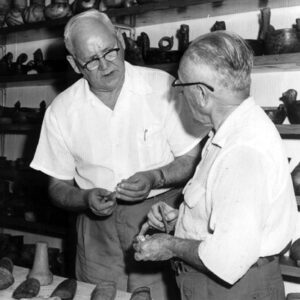calsfoundation@cals.org
Samuel Claudius Dellinger (1892–1973)
Samuel Claudius Dellinger was curator of the University of Arkansas Museum in Fayetteville (Washington County) and head of the Department of Zoology for over thirty years. As curator, he built the museum’s archaeology collection into one of the best in the nation. In Dellinger’s view, the museum was, first and foremost, an educational resource for the people of Arkansas, and he worked to generate interest in it from the university community and the general public.
Samuel Dellinger was born on January 14, 1892, in Iron Station (later Lincolntown), North Carolina, to Robert H. and Laura Loftin Dellinger. After graduating from high school, Dellinger attended Trinity College (later Duke University), where he was a varsity wrestler and swimmer. Dellinger earned his BA degree with honors in 1915 and later was elected to Phi Beta Kappa. Two years after graduating from Duke, he was awarded a master’s degree in zoology from Columbia University.
Dellinger served on the science faculty at Hendrix College in Conway (Faulkner County) from 1915 to 1918. While at Hendrix, he married Elsie Adkisson, daughter of well-known Conway businessman G. W. Adkisson. Dellinger’s research specialty was fish, and after spending the summer conducting research at the renowned Marine Biological Laboratory at Woods Hole, Massachusetts, he began his long career with the University of Arkansas (UA) in Fayetteville in the fall of 1921 as an assistant professor of zoology. Although he completed coursework for a doctoral degree in 1925 at Columbia, he never finished his degree. Shortly after completing his studies, Dellinger returned to the University of Arkansas in 1926 and was appointed curator of the university museum. Around the same time, he was named head of the Department of Zoology, and he held both titles for over thirty years.
During his second year at the university (1922–23), Dellinger organized “Introduction to Anthropology,” which focused on physical anthropology and evolution. In 1928, Arkansas voters passed an act that prohibited teaching evolution in state schools. Dellinger was one of five University of Arkansas faculty members who signed a resolution calling the anti-evolution bill unconstitutional and saying that it interfered with free speech. Dellinger did not stop teaching his anthropology class, and in 1968, the U. S. Supreme Court declared the law unconstitutional in the case of Epperson v. Arkansas.
A gifted raconteur, Dellinger maintained an active schedule of public lectures around the state, but these were not Dellinger’s only public service. He was appointed to the state Basic Science Board in 1928, and in 1937, Dellinger was named an ex-officio member of the Arkansas Game and Fish Commission, holding both positions until he retired.
Dellinger was very protective of Arkansas’s rich archaeological heritage and often denounced what he viewed as the pillaging of Arkansas by out-of-state museums. His concerns were not off the mark, and it was this attitude that spurred Dellinger to obtain the research grants that built the archaeology collections of the University of Arkansas Museum into one of the finest in the nation. His archaeological field crews obtained many complete Native American pottery vessels from northeastern Arkansas, as well as unique, remarkably well-preserved organic artifacts (baskets, sandals, and other normally perishable items) from bluff shelters in the Ozarks. During the mid-1930s, Dellinger obtained and catalogued a number of extraordinary artifacts that had been looted from the Craig Mound at Spiro, Oklahoma. Some of these objects are among the most important in the museum collections.
Although Dellinger was very interested in archaeology, by no means did he neglect building the museum’s collections in other areas. A biologist by training, it was only natural that he should continue to acquire plant and animal specimens, but Dellinger also increased the mineral and fossil collection and broadened the collections to include such areas as Greek and Roman antiquities, American glassware, birds‘ eggs, and Arkansas folk pottery.
Dellinger also found time to pursue his other many and varied interests. In 1928, Dellinger, with Sam Leath and Vance Randolph, organized the first folklore meeting in Arkansas at Eureka Springs (Carroll County). He also worked hard on behalf of environmental conservation efforts in Arkansas, including protection of what would become the Buffalo National River.
In 1957, Dellinger formally retired from the University of Arkansas, though he continued to work on a part-time basis for the next three years. He remained active in retirement. Continuing his interest in biology, he began growing ornamental gourds and corresponded with gourd growers around the world. As chairman of Fayetteville’s City Beautification Committee, Dellinger had more than 1,000 red and white dogwoods planted around town. In 1960, he served as the first president of the Arkansas Chapter of the Nature Conservancy and also became the first president of the newly formed Arkansas Archeological Society.
Dellinger’s wife passed away in 1969, and during his final years, his own health was poor. He suffered from glaucoma and Parkinson’s disease, but his mind retained a keen edge.
Samuel Dellinger died on August 12, 1973, in Fayetteville and was buried in Fairview Memorial Gardens. He was survived by his daughter Martha Ellen, a brother, and four sisters.
For additional information:
Jones, Jennifer. “UA Zoologist May Have ‘Retired,’ But…” Arkansas Gazette. June 9, 1968, p. 5E.
Mainfort, Robert C., Jr. Sam Dellinger: Raiders of the Lost Arkansas. Fayetteville: University of Arkansas Press, 2008.
Obituary of Samuel C. Dellinger. Northwest Arkansas Times. August 13, 1973, p. 2.
Obituary of Samuel C. Dellinger. Springdale News. August 13, 1973, p. 7.
Sam Dellinger: Raiders of the Lost Arkansas Collection. Old State House Museum Online Collections. Lost Arkansas Collection (accessed May 18, 2011).
Samuel Dellinger Papers. Special Collections. University of Arkansas Libraries, Fayetteville, Arkansas.



 Sam Dellinger
Sam Dellinger  Samuel Dellinger
Samuel Dellinger 



Comments
No comments on this entry yet.